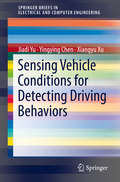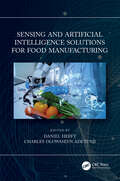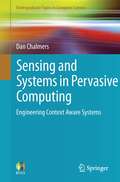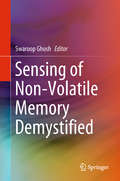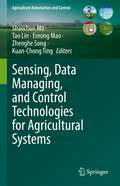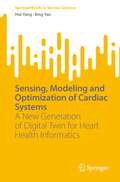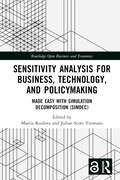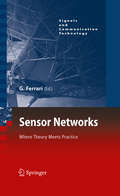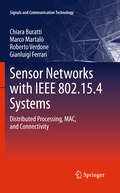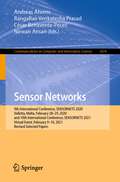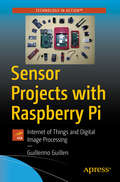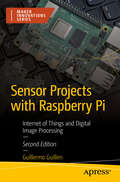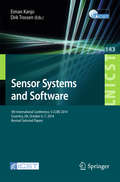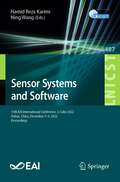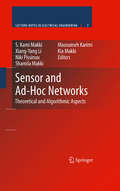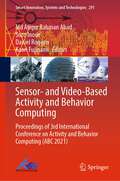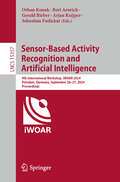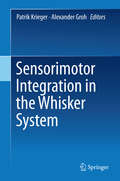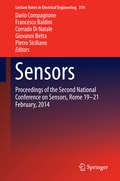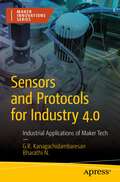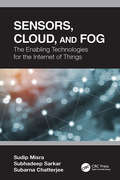- Table View
- List View
Sensing Vehicle Conditions for Detecting Driving Behaviors (Springerbriefs In Electrical And Computer Engineering)
by Yingying Chen Jiadi Yu Xiangyu XuThis SpringerBrief begins by introducing the concept of smartphone sensing and summarizing the main tasks of applying smartphone sensing in vehicles. Chapter 2 describes the vehicle dynamics sensing model that exploits the raw data of motion sensors (i.e., accelerometer and gyroscope) to give the dynamic of vehicles, including stopping, turning, changing lanes, driving on uneven road, etc. Chapter 3 detects the abnormal driving behaviors based on sensing vehicle dynamics. Specifically, this brief proposes a machine learning-based fine-grained abnormal driving behavior detection and identification system, D3, to perform real-time high-accurate abnormal driving behaviors monitoring using the built-in motion sensors in smartphones.As more vehicles taking part in the transportation system in recent years, driving or taking vehicles have become an inseparable part of our daily life. However, increasing vehicles on the roads bring more traffic issues including crashes and congestions, which make it necessary to sense vehicle dynamics and detect driving behaviors for drivers. For example, sensing lane information of vehicles in real time can be assisted with the navigators to avoid unnecessary detours, and acquiring instant vehicle speed is desirable to many important vehicular applications. Moreover, if the driving behaviors of drivers, like inattentive and drunk driver, can be detected and warned in time, a large part of traffic accidents can be prevented. However, for sensing vehicle dynamics and detecting driving behaviors, traditional approaches are grounded on the built-in infrastructure in vehicles such as infrared sensors and radars, or additional hardware like EEG devices and alcohol sensors, which involves high cost. The authors illustrate that smartphone sensing technology, which involves sensors embedded in smartphones (including the accelerometer, gyroscope, speaker, microphone, etc.), can be applied in sensing vehicle dynamics and driving behaviors. Chapter 4 exploits the feasibility to recognize abnormal driving events of drivers at early stage. Specifically, the authors develop an Early Recognition system, ER, which recognize inattentive driving events at an early stage and alert drivers timely leveraging built-in audio devices on smartphones. An overview of the state-of-the-art research is presented in chapter 5. Finally, the conclusions and future directions are provided in Chapter 6.
Sensing and Artificial Intelligence Solutions for Food Manufacturing
by Daniel HefftThis book gives readers a practical introduction into machine learning and sensing techniques, their design and ultimately specific applications that could improve food production. It shows how these sensing and computing systems are suitable for process implementation in food factories. This book starts by giving the reader an overview of the historic structures of food manufacturing standards and how they defined today’s manufacturing. It is followed by a topical introduction for professionals in the food industries in topics such as AI, machine learning, and neural networks. It also includes an explanation of the different sensor systems and their basic principles. It shows how these sensing and computing systems are suitable for process implementation in food factories and what types of sensing systems have already been proven to deliver benefit to the food manufacturing industries. The authors also discuss issues around food safety, labelling, and traceability and how sensing and AI can help to resolve issues. They also use case studies and specific examples that can show the benefit of such technologies compared to current approaches. This book is a practical introduction and handbook for students, food engineers, technologists and process engineers on the benefits and challenges around modern manufacturing systems following Industry 4.0 approaches.
Sensing and Systems in Pervasive Computing
by Dan ChalmersFocus on issues and principles in context awareness, sensor processing and software design (rather than sensor networks or HCI or particular commercial systems). Designed as a textbook, with readings and lab problems in most chapters. Focus on concepts, algorithms and ideas rather than particular technologies.
Sensing of Non-Volatile Memory Demystified
by Swaroop GhoshThis book introduces readers to the latest advances in sensing technology for a broad range of non-volatile memories (NVMs). Challenges across the memory technologies are highlighted and their solutions in mature technology are discussed, enabling innovation of sensing technologies for future NVMs. Coverage includes sensing techniques ranging from well-established NVMs such as hard disk, flash, Magnetic RAM (MRAM) to emerging NVMs such as ReRAM, STTRAM, FeRAM and Domain Wall Memory will be covered.
Sensing, Data Managing, and Control Technologies for Agricultural Systems (Agriculture Automation and Control)
by Tao Lin Shaochun Ma Enrong Mao Zhenghe Song Kuan-Chong TingAgricultural automation is the emerging technologies which heavily rely on computer-integrated management and advanced control systems. The tedious farming tasks had been taken over by agricultural machines in last century, in new millennium, computer-aided systems, automation, and robotics has been applied to precisely manage agricultural production system. With agricultural automation technologies, sustainable agriculture is being developed based on efficient use of land, increased conservation of water, fertilizer and energy resources. The agricultural automation technologies refer to related areas in sensing & perception, reasoning & learning, data communication, and task planning & execution. Since the literature on this diverse subject is widely scattered, it is necessary to review current status and capture the future challenges through a comprehensive monograph.In this book we focus on agricultural automation and provide critical reviews of advanced control technologies, their merits and limitations, application areas and research opportunities for further development. This collection thus serves as an authoritative treatise that can help researchers, engineers, educators, and students in the field of sensing, control, and automation technologies for production agriculture.
Sensing, Modeling and Optimization of Cardiac Systems: A New Generation of Digital Twin for Heart Health Informatics (SpringerBriefs in Service Science)
by Hui Yang Bing YaoThis book reviews the development of physics-based modeling and sensor-based data fusion for optimizing medical decision making in connection with spatiotemporal cardiovascular disease processes. To improve cardiac care services and patients’ quality of life, it is very important to detect heart diseases early and optimize medical decision making. This book introduces recent research advances in machine learning, physics-based modeling, and simulation optimization to fully exploit medical data and promote the data-driven and simulation-guided diagnosis and treatment of heart disease. Specifically, it focuses on three major topics: computer modeling of cardiovascular systems, physiological signal processing for disease diagnostics and prognostics, and simulation optimization in medical decision making. It provides a comprehensive overview of recent advances in personalized cardiac modeling by integrating physics-based knowledge of the cardiovascular system with machine learning and multi-source medical data. It also discusses the state-of-the-art in electrocardiogram (ECG) signal processing for the identification of disease-altered cardiac dynamics. Lastly, it introduces readers to the early steps of optimal decision making based on the integration of sensor-based learning and simulation optimization in the context of cardiac surgeries. This book will be of interest to researchers and scholars in the fields of biomedical engineering, systems engineering and operations research, as well as professionals working in the medical sciences.
Sensitivity Analysis for Business, Technology, and Policymaking: Made Easy with Simulation Decomposition (SimDec) (Routledge Open Business and Economics)
by Mariia Kozlova Julian Scott YeomansSimDec is a revolution in decision-making support. SimDec “teases out” inherent cause-and-effect relationships and reveals the intricacy of relationships between sets of input and output variables. At its core, SimDec is an amalgamation of uncertainty and global sensitivity analysis with an innovative visualization technique. While straightforward and elegant, this novel approach significantly enhances the analytical capabilities of users by readily exposing seemingly, a priori, counterintuitive behaviours so that they can be readily understood by both technical specialists and non-technical users alike.This book is the first to articulate the ubiquitous applicability of SimDec and has been written by the leading proponents of the technique. The book provides the necessary background to fully understand the underlying approach and then demonstrates its applicability to a wide spectrum of fields, such as finance, entrepreneurship, energy, 3D manufacturing, geology, the environment, engineering, public policy, and even superconducting magnets. To facilitate as widespread adoption and penetration of SimDec as possible, all supporting computer codes are available, open-source, in Python, Julia, R, and Matlab.The innovative material will be of primary benefit to practitioners and researchers analyzing data from the social sciences, business, science, engineering, mathematics, and computing.The Open Access version of this book, available at http://www.taylorfrancis.com, has been made available under a Creative Commons [Attribution-Non Commercial-No Derivatives (CC-BY-NC-ND)] 4.0 license.
Sensitivity Analysis for Neural Networks
by Wing W. Ng Daming Shi Ian Cloete Daniel S. YeungArtificial neural networks are used to model systems that receive inputs and produce outputs. The relationships between the inputs and outputs and the representation parameters are critical issues in the design of related engineering systems, and sensitivity analysis concerns methods for analyzing these relationships. Perturbations of neural networks are caused by machine imprecision, and they can be simulated by embedding disturbances in the original inputs or connection weights, allowing us to study the characteristics of a function under small perturbations of its parameters. This is the first book to present a systematic description of sensitivity analysis methods for artificial neural networks. It covers sensitivity analysis of multilayer perceptron neural networks and radial basis function neural networks, two widely used models in the machine learning field. The authors examine the applications of such analysis in tasks such as feature selection, sample reduction, and network optimization. The book will be useful for engineers applying neural network sensitivity analysis to solve practical problems, and for researchers interested in foundational problems in neural networks.
Sensor Networks
by Gianluigi FerrariThis book collects very recent results in the realm of sensor networking. In particular, it links the theory of sensor networking with practical and implementation aspects. Such, it highlights how sensor networking represents a very interesting research/application area, allowing a researcher to apply his theories and a practitioner to "see" the theories behind his/her used technologies.
Sensor Networks and Signal Processing: Proceedings of the 2nd Sensor Networks and Signal Processing (SNSP 2019), 19-22 November 2019, Hualien, Taiwan (Smart Innovation, Systems and Technologies #176)
by Margarita N. Favorskaya Han-Chieh Chao Sheng-Lung PengThis book offers a collection of high-quality research papers presented at the 2nd International Conference on Sensor Networks and Signal Processing (SNSP 2019), held in Taiwan on November 19–22, 2019. It presents novel contributions in the areas of sensor and actuator networks, wireless networks, networking and protocols, security and privacy, wireless communications, distributed algorithms, Internet of Things, system modeling and performance analysis, fault tolerance/diagnostics, information management, data mining and analysis, embedded systems design, signal theory, signal and image processing, detection and estimation, spectral analysis, software developments, pattern recognition, data processing, remote sensing, big data, machine learning, information and coding theory, and industrial applications.
Sensor Networks with IEEE 802.15.4 Systems
by Roberto Verdone Gianluigi Ferrari Marco Martalo' Chiara BurattiThis book presents a simple, yet complete, approach to the design and performance analysis of distributed processing algorithms and techniques suitable for IEEE 802.15.4 networks. In particular, the book focuses on the bottom two layers of the ISO/OSI stack (Physical and Medium Access Control), discussing also a few issue related to routing. The book is a the synergistic combination of signal processing aspects on the one hand and MAC and connectivity issues on the other hand. The goal of the book is to clearly link physical layer aspects with medium access and topology aspects, in order to provide the reader with a clear understanding of how to approach the design of proper distributed signal processing and medium access algorithms in this context.
Sensor Networks: 6th International Conference, SENSORNETS 2017, Porto, Portugal, February 19-21, 2017, and 7th International Conference, SENSORNETS 2018, Funchal, Madeira, Portugal, January 22-24, 2018, Revised Selected Papers (Communications in Computer and Information Science #1074)
by César Benavente-Peces Nancy Cam-Winget Eric Fleury Andreas AhrensThis book constitutes the refereed proceedings of the 6th International Conference, SENSORNETS 2017, Porto, Portugal, held in February 2017, and the 7th International Conference, SENSORNETS 2018, Funchal, Madeira, Portugal, held in January 2018. The 18 full papers presented were carefully reviewed and selected from 67 submissions. The papers cover the following topics: sensor networks, including hardware of sensor networks, wireless communication protocols, sensor networks software and architectures, wireless information networks, data manipulation, signal processing, localization and object tracking through sensor networks, obstacles, applications and uses.
Sensor Networks: 9th International Conference, SENSORNETS 2020, Valletta, Malta, February 28–29, 2020, and 10th International Conference, SENSORNETS 2021, Virtual Event, February 9–10, 2021, Revised Selected Papers (Communications in Computer and Information Science #1674)
by Nirwan Ansari César Benavente-Peces Andreas Ahrens RangaRao Venkatesha PrasadThis book constitutes selected and revised papers of the 9th International Conference, SENSORNETS 2020, Valletta, Malta, held in February 2020, and the 10th International Conference, SENSORNETS 2021, held virtually in February 2021. The 7 full papers presented were carefully reviewed and selected from 60 submissions. They focus in all aspects of sensor networks, including hardware of sensor networks, wireless communication protocols, sensor networks software, hardware and architectures, wireless information networks, channel characterization, data manipulation, signal processing, localization and object tracking through sensor networks, modelling and simulation, applications and uses.
Sensor Projects with Raspberry Pi: Internet of Things and Digital Image Processing
by Guillermo GuillenStart solving world issues by beginning small with simple Rasperry Pi projects. Using a free IoT server; tackle fundamental topics and concepts behind the Internet of Things. Image processing and sensor topics aren’t only applicable to the Raspberry Pi. The skills learned in this book can go own to other applications in mobile development and electrical engineering. Start by creating a system to detect movement through the use of a PIR motion sensor and a Raspberry Pi board. Then further your sensor systems by detecting more than simple motion. Use the MQ2 gas sensor and a Raspberry Pi board as a gas leak alarm system to detect dangerous explosive and fire hazards. Train your system to send the captured data to the remote server ThingSpeak. When a gas increase is detected beyond a limit, then a message is sent to your Twitter account. Having started with ThingSpeak, we’ll go on to develop a weather station with your Raspberry Pi. Using the DHT11 (humidity and temperature sensor) and BMP085 (barometric pressure and temperature sensor) in conjunction with ThingSpeak and Twitter, you can receive realtime weather alerts from your own meterological system!Finally, expand your skills into the popular machine learning world of digital image processing using OpenCV and a Pi. Make your own object classifiers and finally manipulate an object by means of an image in movement. This skillset has many applications, ranging from recognizing people or objects, to creating your own video surveillance system.With the skills developed in this book, you will have everything you need to work in IoT projects for the Pi. You can then expand your skills out further to develop mobile projects and delve into interactive systems such as those found in machine learning.What You'll LearnWork with ThingSpeak to receive Twitter alerts from your systemsCultivate skills in processing sensor inputs that are applicable to mobile and machine learning projects as wellIncorporate sensors into projects to make devices that interact with more than just codeWho This Book Is ForHobbyists and makers working robotics and Internet of Things areas will find this book a great resource for quick but expandable projects. Electronics engineers and programmers who would like to expand their familiarity with basic sensor projects will also find this book helpful.
Sensor Projects with Raspberry Pi: Internet of Things and Digital Image Processing (Maker Innovations Series)
by Guillermo GuillenUse Python to develop Rasperry Pi projects to solve common digital image processing and IoT problems. Using a free IoT server you’ll tackle fundamental topics and concepts behind theses two areas. This second edition includes new content on Artificial Intelligence and updated sensor guidance to help you better explore virtual animations, create a homemade spectrometer, and master object classification with Edge Impulse. Start by creating a system to detect movement with a PIR motion sensor and a Raspberry Pi board. Use the MQ2 gas sensor and a Raspberry Pi board as a gas leak alarm system to detect dangerous explosive and fire hazards. Then train your system to send the captured data to the remote server ThingSpeak. You’ll also develop a weather station with your Raspberry Pi. Using the DHT11 (humidity and temperature sensor) and BMP (barometric pressure and temperature sensor) in conjunction with ThingSpeak and X, you can receive real time weather alerts from your own meterological system! Spectral sensers used with the Raspberry Pi include the AS7262 (six colors), and AS7263 (near infrared) for the construction of a filter spectrometer, sensing colored solutions, and assessing plant foliage health. Finally, expand your skills into the popular machine learning world of digital image processing using OpenCV and a Pi. Make your own object classifiers and finally manipulate an object by means of an image in movement. This skillset has many applications, ranging from recognizing people or objects, to creating your own video surveillance system. With the skills gained from Sensor Projects with Raspberry Pi, you'll be well-equipped to explore other applications in mobile development and electrical engineering as well. What You'll Learn Work with ThingSpeak to receive X alerts from your systems. Cultivate skills in processing sensor inputs that are applicable to mobile and machine learning projects. Incorporate sensors into projects to make interactive devices. Experiment with virtual scenarios and objects. Create Python and Pygame games that contain virtual scenarios and animations. Detect colored solutions and assess the plant foliage health. Who This Book Is For Hobbyists and makers working with robotics and IoT. Electronic engineers and programmers who would like to expand their familiarity with basic sensor projects.
Sensor Systems and Software
by Eiman Kanjo Dirk TrossenThis book constitutes the thoroughly refereed post-conference proceedings of the 5th International Conference on Sensor Systems and Software, S-Cube 2014, held in Coventry, UK, in October 2014. The 12 revised full papers presented were selected from 16 submissions and cover technologies for wireless sensor networks, including security protocols, middleware, analysis tools and frameworks.
Sensor Systems and Software: 13th EAI International Conference, S-Cube 2022, Dalian, China, December 7-9, 2022, Proceedings (Lecture Notes of the Institute for Computer Sciences, Social Informatics and Telecommunications Engineering #487)
by Ning Wang Hamid Reza KarimiThis book constitutes the proceedings of the 13th International Conference on Sensor Systems and Software, S-Cube 2022, which was held in Dalian, China, in December 7-9, 2022. The 16 revised full papers in this book were selected from 42 submissions and are organized in three thematic sessions on sensor technology for marine systems; resilience control systems; and applications.
Sensor and Ad-Hoc Networks
by Xiang-Yang Li Kia Makki S. Kami Makki Niki Pissinou Masoumeh Karimi Shamila MakkiThis book brings together leading researchers and developers in the field of wireless sensor networks to explain the special problems and challenges of the algorithmic aspects of sensor and ad-hoc networks. The book also fosters communication not only between the different sensor and ad-hoc communities, but also between those communities and the distributed systems and information systems communities. The topics addressed pertain to the sensors and mobile environment.
Sensor- and Video-Based Activity and Behavior Computing: Proceedings of 3rd International Conference on Activity and Behavior Computing (ABC 2021) (Smart Innovation, Systems and Technologies #291)
by Sozo Inoue Daniel Roggen Md Atiqur Rahman Ahad Kaori FujinamiThis book presents the best-selected research papers presented at the 3rd International Conference on Activity and Behavior Computing (ABC 2021), during 20–22 October 2021. The book includes works related to the field of vision- and sensor-based human action or activity and behavior analysis and recognition. It covers human activity recognition (HAR), action understanding, gait analysis, gesture recognition, behavior analysis, emotion, and affective computing, and related areas. The book addresses various challenges and aspects of human activity recognition—both in sensor-based and vision-based domains. It can be considered as an excellent treasury related to the human activity and behavior computing.
Sensor-Based Activity Recognition and Artificial Intelligence: 9th International Workshop, iWOAR 2024, Potsdam, Germany, September 26–27, 2024, Proceedings (Lecture Notes in Computer Science #15357)
by Arjan Kuijper Orhan Konak Bert Arnrich Gerald Bieber Sebastian FudickarThis book constitutes the proceedings of the 9th International Workshop on Sensor-Based Activity Recognition and Artificial Intelligence, iWOAR 2024, held in Potsdam, Germany, during September 26–27, 2024. The 15 full papers and 4 short papers presented here were carefully reviewed and selected from 28 submissions. These papers have been categorized into the following topical sections: Advances in Human Activity Recognition; Applications in Vision-Based Recognition; Wearable Devices and Health Monitoring; Novel AI and Machine Learning Approaches; Short Papers: Emerging Topics in Sensor-Based Systems.
Sensorimotor Integration in the Whisker System
by Patrik Krieger Alexander GrohSensorimotor integration, the dynamic process by which the sensory and motor systems communicate with each other, is crucial to humans' and animals' ability to explore and react to their environment. This book summarizes the main aspects of our current understanding of sensorimotor integration in 10 chapters written by leading scientists in this active and ever-growing field. This volume focuses on the whisker system, which is an exquisite model to experimentally approach sensorimotor integration in the mammalian brain. In this book, authors examine the whisker system on many different levels, ranging from the building blocks and neuronal circuits to sensorimotor behavior. Neuronal coding strategies, comparative analysis as well as robotics illustrate the multiple facets of this research and its broad impact on fundamental questions about the neurobiology of the mammalian brain.
Sensors
by Corrado Di Natale Pietro Siciliano Dario Compagnone Francesco Baldini Giovanni BettaThis book contains a selection of papers presented at the Second National Conference on Sensors held in Rome 19-21 February 2014. The conference highlighted state-of-the-art results from both theoretical and applied research in the field of sensors and related technologies. This book presents material in an interdisciplinary approach, covering many aspects of the disciplines related to sensors, including physics, chemistry, materials science, biology and applications.
Sensors and Protocols for Industry 4.0: Industrial Applications of Maker Tech (Maker Innovations Series)
by G. R. Kanagachidambaresan Bharathi NThis book Identifies the right sensors and single board computers for any application to achieve the best performance in Industry 4.0 settings and applications. You’ll see what technologies apply the IIoT with elegant efficiency to drastically improve remote monitoring and controlling, decision making, and preventative maintenance. Start by learning exactly what Industry 4.0 is and advance your knowledge from simple Internet of Things projects to full-on Industrial IoT deployment. You'll automate advanced processes, incorporate professional procedures, and take your IoT skills to a professional level. Then move into the protocols and standards expected for industrial applications of sensors at an industrial level. Match the right SBCs to the right use cases and sensor technologies to optimize efficiency and ensure peak performance. Then move into setting up a smart factory and monitoring your supply chain with tech. Finally, you'll dive into programming with the Node-Red platform and Python packages for CPS. By the end of this book, you’ll have jumped from simple, home-based IoT systems up to industrial and professional applications. Conquer your supply chain and both forward and backward processes with accessible Maker tech! What You'll Learn Support industrial applications of SBCs and Maker tech Achieve peak performance by combining the right sensors with the right processing boards Improve remote monitoring and controlling drastically for better decision making and preventative maintenance Who This Book Is For Students and aspiring professionals working with Internet of things technologies moving towards industrial applications. Prerequisite knowledge in basic Internet of Things, simple python concepts, automation, and industry procedures is required for this book. Engineers and scientists who are pursuing research and contributing to industrial internet of things might also benefit.
Sensors for Mobile Robots
by H.R. EverettThe author compiles everything a student or experienced developmental engineer needs to know about the supporting technologies associated with the rapidly evolving field of robotics.From the table of contents: Design Considerations * Dead Reckoning * Odometry Sensors * Doppler and Inertial Navigation * Typical Mobility Configurations * Tactile and
Sensors, Cloud, and Fog: The Enabling Technologies for the Internet of Things
by Sudip Misra Subhadeep Sarkar Subarna ChatterjeeThis book provides an in-depth understanding of Internet of Things (IoT) technology. It highlights several of today's research and technological challenges of translating the concept of the IoT into a practical, technologically feasible, and business-viable solution. It introduces two novel technologies--sensor-cloud and fog computing--as the crucial enablers for the sensing and compute backbone of the IoT. The book discusses these two key enabling technologies of IoT that include a wide range of practical design issues and the futuristic possibilities and directions involving sensor networks and cloud and fog computing environments towards the realization and support of IoT. Classroom presentations and solutions to end of chapter questions are available to instructors who use the book in their classes.
